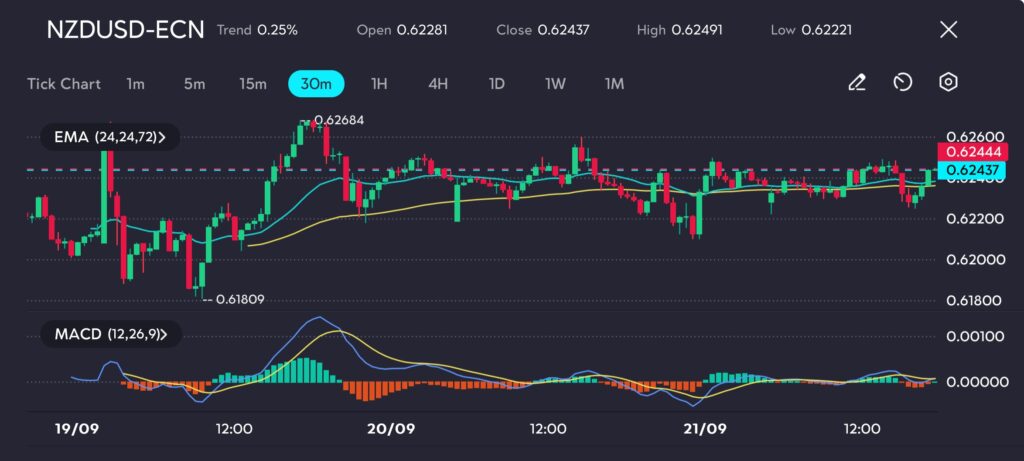Key points:
- NZDUSD holds steady at $0.624 as investors await key economic data and Fed speeches for future rate guidance.
- The Q2 economic contraction in New Zealand reinforces expectations for more RBNZ rate cuts, with markets fully pricing in a 25bps cut in October.
The New Zealand dollar hovered around $0.624, reflecting caution as markets await U.S. economic data and comments from Federal Reserve officials that could provide fresh insights into interest rate policies.

Picture: NZDUSD prices stable as markets seek more clues, as observed on the VT Markets app.
The NZD/USD pair is currently trading around the 0.6244 level, after reaching an intraday high of 0.6249. The price is showing signs of consolidation, as traders continue to evaluate economic data and potential central bank actions.
The moving averages, particularly the 24-period EMA, are showing a mixed trend, with the price hovering just around the short-term moving average. The MACD has flattened, indicating that momentum is subdued in the current market environment.
The contraction in New Zealand’s economy during the second quarter has heightened expectations for the Reserve Bank of New Zealand (RBNZ) to adopt a more dovish stance. Further monetary easing could place additional downward pressure on the NZD. Should the currency break below the 0.6220 support level, we could see further declines, while resistance at 0.6268 remains key for any potential bullish recovery.
Market participants are fully pricing in another 25-basis-point rate cut in October, with the likelihood of additional easing before the end of the year.
Related topic: Interest rate tug-of-war for central banks
Global impact on NZD
Globally, the Federal Reserve’s decision last week to lower interest rates by 50 basis points, has shaped the overall market sentiment. Typically, a rate cut lowers the value of the U.S. dollar, which provides a short-term lift to other currencies, including the New Zealand dollar.
However, the mixed U.S. economic outlook is creating uncertainty. While the labour market has shown signs of weakness, inflation pressures remain a concern, keeping investors on edge about future Fed decisions.
In this context, further U.S. economic data could shift the outlook for both currencies. With inflation data and Fed speeches scheduled this week, any hawkish or dovish surprises could influence the NZDUSD currency pair.
Domestic factors affecting monetary policy of the RBNZ
The Q2 economic data of New Zealand highlights a struggling economy. The contraction, combined with weak business and consumer confidence, has reinforced market expectations that the RBNZ will need to continue its rate-cutting cycle.
The RBNZ has already reduced rates by 25 basis points in August, and another cut of the same size is fully priced in for October.
This weak economic performance poses risks for the NZD, as further easing by the RBNZ would reduce the appeal of holding the currency.
Lower rates tend to drive away investors seeking higher yields, adding pressure to the NZD in the near term. However, in the longer term, aggressive monetary easing may provide the stimulus needed to revive growth.
Market outlook, risks and opportunities
For short-term traders, the direction of the NZD will likely hinge on two major factors: Global risk sentiment tied to U.S. economic data and Fed decisions, and the pace of monetary easing by the RBNZ.
Any positive surprises in U.S. data could lift the US dollar and weigh on the NZD, while more dovish Fed comments could provide relief for the kiwi.
Traders will be watching for any signs of improvement in the New Zealand economy that could temper expectations for aggressive rate cuts.









